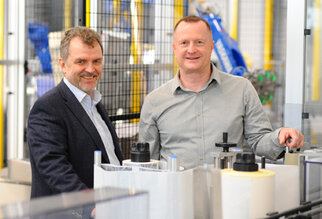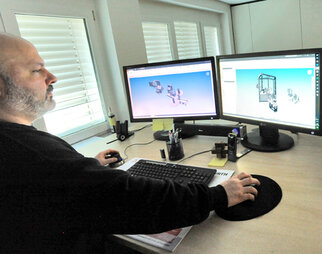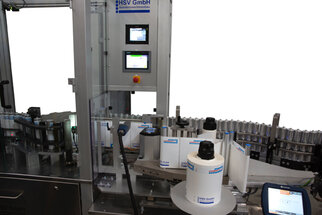When filling and packaging highly viscous or reactive fillers such as 2-component adhesives and impression materials for dental applications, extreme precision and maximum process reliability are required. Any entrapment of ambient air must be prevented to avoid an unwanted reaction such as premature curing. "Our filling and packaging plants are highly automated for this reason alone," says Waldemar Hert, Managing Director of HSV Sondermaschinenbau GmbH. "But also because batch sizes are getting smaller and changeover processes are increasing, we try to eliminate the human factor as much as possible." The company suc-ceeds in doing this to a high level of perfection: HSV is a world leader in its field. As a general contractor, it develops and manu-factures complete systems, from the removal of the filling goods from drums to the finished pallet with the packed containers such as cartridges. It is not uncommon for such facilities to have dimensions of over 200 square meters. Reputable manufacturers on almost every continent rely on cutting-edge technology from Asperg in Württemberg, Germany.
Overriding importance of the interface
HSV is correspondingly exacting in the selection of its suppliers. For label applicators, the company now relies exclusively on the HERMA 500. "Having a Profinet interface is extremely important for us," the HSV managing director stated as one of the reasons. "This allows us to completely integrate the applicator into our own control architecture. All parameters then come from the process control system, and these are automatically adopted by every in-tegrated component of the packaging line. With other suppliers, the interfaces often have to be created with a great deal of pro-gramming effort, if it’s even possible at all." In general, the data flow is very important, especially for a special machine manufac-turer who is constantly facing new challenges: "It is extremely helpful for us to get data in any form, whether in relation to control technology or CAD models. It's no use to us if we get a cheaper applicator but then spend weeks re-modeling it in CAD or creating some EPLAN macros.” The online configurator that HERMA has developed is also a decisive advantage. "In it, we can pre-configure the applicator, including the stand, as we need it," says HSV Operations Manager Jörg Leonberger. "Then we create a CAD model there, download it and use the data in our own CAD system. After 15 to 30 minutes, we have an individually configured applicator including a CAD model and can incorporate this into our design. Without such a configurator, it would sometimes take weeks for special solutions to be implemented before we could continue with the design. After only about four weeks, the finished applicators are ready for installation. "For others, it sometimes takes months," Leonberger reports. This speed is also due to the HERMA 500’s modular design. The same basic unit can be configured for any speed, any installation situation, any dispensing variation. This ensures standardized, reliable series production as well as rapid availability and consistent integration processes.
Demanding containers, high label diversity
The latest HSV system, in which two HERMA 500s were installed, is used for filling a special adhesive used to affix car windscreens. This line is operated in North America. The containers are 20 product variations that are filled in both plastic and aluminum cartridges. In addition, a large number of label variations are used, some in the form of booklet labels. "This is a major challenge for the labeling process," Waldemar Hert emphasizes. "The aluminum cartridges remain nicely cylindrical after filling, but the plastic cartridges become slightly conical or spherical." The HERMA 500 nevertheless ensures high reproducibility of precise and wrinkle-free labeling results. "There is no slippage with the HERMA 500 and the scanning is perfect,” the HSV Managing Director confirms. The HERMA 500 is perfectly capable of handling new labeling challenges that may arise during operation. All parameters can be accessed remotely via the web interface. What the operator sees on the smartphone-sized touch display of his applicator can also be seen by HSV’s technicians via a web-enabled terminal in Asperg. "In coordination with the operator, we can then click through the menus and increase or reduce the value of a specific parameter,” Waldemar Hert says. The reason is simple: "If we were to do something in the background that the operator doesn't notice, he wouldn’t be able to figure it out. This way, he can understand the context and is in a better position to deal with a future irregularity."


